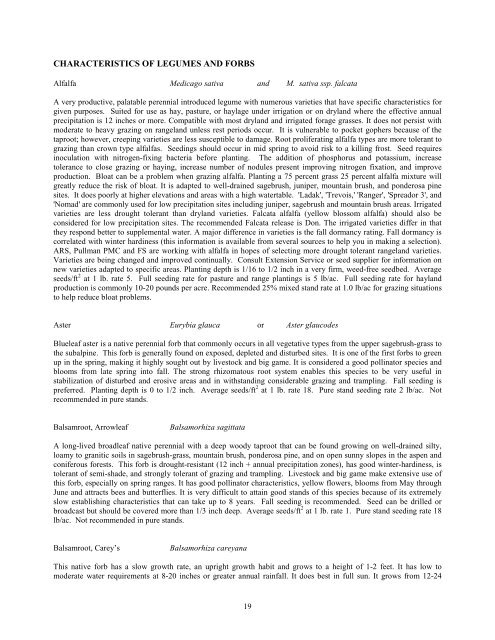Idaho Plant Materials Technical Note No. 24
Idaho Plant Materials Technical Note No. 24
Idaho Plant Materials Technical Note No. 24
You also want an ePaper? Increase the reach of your titles
YUMPU automatically turns print PDFs into web optimized ePapers that Google loves.
CHARACTERISTICS OF LEGUMES AND FORBS<br />
Alfalfa Medicago sativa and M. sativa ssp. falcata<br />
A very productive, palatable perennial introduced legume with numerous varieties that have specific characteristics for<br />
given purposes. Suited for use as hay, pasture, or haylage under irrigation or on dryland where the effective annual<br />
precipitation is 12 inches or more. Compatible with most dryland and irrigated forage grasses. It does not persist with<br />
moderate to heavy grazing on rangeland unless rest periods occur. It is vulnerable to pocket gophers because of the<br />
taproot; however, creeping varieties are less susceptible to damage. Root proliferating alfalfa types are more tolerant to<br />
grazing than crown type alfalfas. Seedings should occur in mid spring to avoid risk to a killing frost. Seed requires<br />
inoculation with nitrogen-fixing bacteria before planting. The addition of phosphorus and potassium, increase<br />
tolerance to close grazing or haying, increase number of nodules present improving nitrogen fixation, and improve<br />
production. Bloat can be a problem when grazing alfalfa. <strong>Plant</strong>ing a 75 percent grass 25 percent alfalfa mixture will<br />
greatly reduce the risk of bloat. It is adapted to well-drained sagebrush, juniper, mountain brush, and ponderosa pine<br />
sites. It does poorly at higher elevations and areas with a high watertable. 'Ladak', 'Trevois,' 'Ranger', 'Spreador 3', and<br />
'<strong>No</strong>mad' are commonly used for low precipitation sites including juniper, sagebrush and mountain brush areas. Irrigated<br />
varieties are less drought tolerant than dryland varieties. Falcata alfalfa (yellow blossom alfalfa) should also be<br />
considered for low precipitation sites. The recommended Falcata release is Don. The irrigated varieties differ in that<br />
they respond better to supplemental water. A major difference in varieties is the fall dormancy rating. Fall dormancy is<br />
correlated with winter hardiness (this information is available from several sources to help you in making a selection).<br />
ARS, Pullman PMC and FS are working with alfalfa in hopes of selecting more drought tolerant rangeland varieties.<br />
Varieties are being changed and improved continually. Consult Extension Service or seed supplier for information on<br />
new varieties adapted to specific areas. <strong>Plant</strong>ing depth is 1/16 to 1/2 inch in a very firm, weed-free seedbed. Average<br />
seeds/ft 2 at 1 lb. rate 5. Full seeding rate for pasture and range plantings is 5 lb/ac. Full seeding rate for hayland<br />
production is commonly 10-20 pounds per acre. Recommended 25% mixed stand rate at 1.0 lb/ac for grazing situations<br />
to help reduce bloat problems.<br />
Aster Eurybia glauca or Aster glaucodes<br />
Blueleaf aster is a native perennial forb that commonly occurs in all vegetative types from the upper sagebrush-grass to<br />
the subalpine. This forb is generally found on exposed, depleted and disturbed sites. It is one of the first forbs to green<br />
up in the spring, making it highly sought out by livestock and big game. It is considered a good pollinator species and<br />
blooms from late spring into fall. The strong rhizomatous root system enables this species to be very useful in<br />
stabilization of disturbed and erosive areas and in withstanding considerable grazing and trampling. Fall seeding is<br />
preferred. <strong>Plant</strong>ing depth is 0 to 1/2 inch. Average seeds/ft 2 at 1 lb. rate 18. Pure stand seeding rate 2 lb/ac. <strong>No</strong>t<br />
recommended in pure stands.<br />
Balsamroot, Arrowleaf<br />
Balsamorhiza sagittata<br />
A long-lived broadleaf native perennial with a deep woody taproot that can be found growing on well-drained silty,<br />
loamy to granitic soils in sagebrush-grass, mountain brush, ponderosa pine, and on open sunny slopes in the aspen and<br />
coniferous forests. This forb is drought-resistant (12 inch + annual precipitation zones), has good winter-hardiness, is<br />
tolerant of semi-shade, and strongly tolerant of grazing and trampling. Livestock and big game make extensive use of<br />
this forb, especially on spring ranges. It has good pollinator characteristics, yellow flowers, blooms from May through<br />
June and attracts bees and butterflies. It is very difficult to attain good stands of this species because of its extremely<br />
slow establishing characteristics that can take up to 8 years. Fall seeding is recommended. Seed can be drilled or<br />
broadcast but should be covered more than 1/3 inch deep. Average seeds/ft 2 at 1 lb. rate 1. Pure stand seeding rate 18<br />
lb/ac. <strong>No</strong>t recommended in pure stands.<br />
Balsamroot, Carey’s<br />
Balsamorhiza careyana<br />
This native forb has a slow growth rate, an upright growth habit and grows to a height of 1-2 feet. It has low to<br />
moderate water requirements at 8-20 inches or greater annual rainfall. It does best in full sun. It grows from 12-<strong>24</strong><br />
19
















